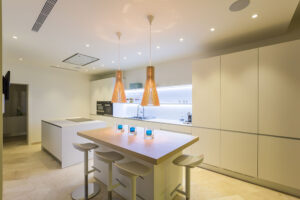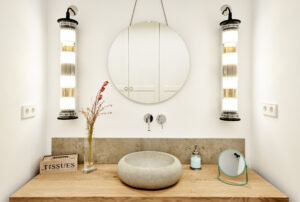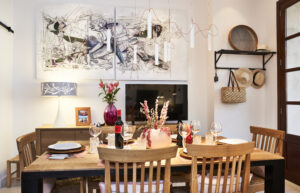How to illuminate a luxury home?
Luxury homes require special lighting not only for the mere fact of being a luxury home but also because its dimensions, the number of rooms, the decorative style and functionality of each of them, and the customer's demand for excellence and perfection makes the lighting in these homes become very important not only decorative but also at a technical level.
In this type of housing there is a lot of game to decorate with lamps that are rather jewels but the technical lighting has a fundamental role and has to be studied with thoroughness and success. The lighting that we define for each of these environments will be part "guilty" when it comes to harmonize them in space.
The first thing to consider is the type of light that we will need in each room. The interior lighting of luxury homes requires a strategy when we want to illuminate it. Each room needs a lighting that is cozy and at the same time functional, appropriate to the use that is going to be given. Therefore, we will not illuminate a living room the same as a bedroom, or a kitchen the same as a hallway. It is important to avoid over-lighting areas that require ambient light, such as a bedroom, and leave in semi-darkness places where you need functional light, such as the work area in a kitchen or the mirrors in the bathrooms. The type of interior lighting in the house will be different depending on the room we are dealing with.
Lighting in bedrooms or large living rooms
Large rooms need to integrate several types of lighting. We cannot leave a large room with only and exclusively ceiling lights. The lighting should not rely exclusively on this type of lighting. We must complement the lighting with wall sconces, floor lamps, reading lamps or table lamps, here we would be entering a decorative field in which selecting the perfect lamp has to be in tune with the rest of the interior design. An important point is to generate different light effects depending on the moment. We will not want the same light in the living room if we are chatting with friends, if we are watching TV or if we are enjoying a moment of relaxation.
The perfect lighting for a dining room
When we enter a dining room, the main lighting will focus on the table. The place around which people gather, converse and enjoy great celebrations. The lighting must be, above all, pleasant and warm. It must be powerful enough to see well what we eat and, at the same time, invite to enjoy the table.
Hanging lamps are back in the spotlight. We return again to the decorative lamps. In the market we find real jewels that will go in line with the rest of the decor. Of course, when you are choosing your lamp you should pay attention to its height with respect to the table top. The bottom of the lamp and the table should be at a minimum distance between 70 and 90 centimeters. At no time should it take away the view of the participants at the table.
Light points in a large kitchen
When we are in front of a kitchen we must not lose sight of the utility that is given to each space. Where we are going to cook, where we are going to work the raw material, etc. The lighting in a kitchen is where it should be more functional but does not prevent us from playing with decorative lighting that brings personality and style to our kitchen. Think of the place of the stove, sink and work areas, in these places there must be good light to facilitate the work in the kitchen.
On the rise is the use of recessed or surface profiles in which you can adapt different types of luminaires that will allow you to create from a general lighting in work areas, the enhancement of all the high furniture and even integrate suspended lights for lighting tables or islands, so in use in kitchens of prime homes.

Lighting in bedrooms
It is our sacred place, here we must feel the comfort, we must be able to create an environment that invites us to calm and relaxation. Therefore we will opt for diffuse and warm lights. Leaving more emphasis on the dressing room area or the different closets.
Of course, the bedrooms give us room to arrange beautiful and elegant bedside lamps or leave them suspended on the sides of the bed, creating a pleasant environment to read a few pages before going to sleep.
Bathrooms, a challenge for lighting
The bathroom is another room that requires good general lighting. Practicing some ceiling recessing to integrate LED strips and thus create an ambient lighting will be the first step to create an ambient lighting. In the mirror area it is essential to use recessed or surface luminaires that illuminate directly, but with an extensive beam and complement it with front lighting on the mirror or on both sides. For this, the use of wall sconces is essential: they will be in charge of providing uniformity, softening the shadows caused by the zenithal illumination. The combination of these 3 elements will be the best way to have a correct illumination when you want to make up or shave and have a shadow-free illumination.
In the shower area it is advisable to install one or two ceiling lights, everything will depend on the space. And for the bathtubs we suggest a more comfortable lighting that invites us to relax.
It is important to bear in mind that, in the lighting of bathrooms where there is a shower or bathtub, therefore HUMIDITY, we will always use luminaires with an adequate level of watertightness for use in humid areas and thus avoid future problems.

Types of interior lamps
- Wall lamps. They are usually used as ambient and diffused lighting. They can be part of the lighting of corridors, living rooms, bedrooms and, in general, be the ideal complement to other lighting fixtures. Nowadays there are so many models and finishes of this type of lighting that it can be difficult to decide on a specific one.
- Suspended lamps. They are usually used as general and ambient lighting. They are usually the main protagonists of living rooms and stairwells. They give presence to the room by having a greater decorative impact, either by their size, shape or design.
- Floor lamps. A classic in living rooms, although they are also extensive in the lighting of large bedrooms and other rooms. They are portable lamps that serve to provide a punctual or general light where it is needed. They usually emit indirect light directed towards the ceiling or wall, or diffused through all kinds of screens made of a wide variety of materials.
- Table lamps. Common in living rooms, bedrooms and some auxiliary furniture. Sometimes they act more as a decorative element than as a simple point of light. Like their big sisters the floor lamps, they are usually portable and are manufactured in a multitude of materials, shapes and finishes. Of every day more in use the models that incorporate battery: you can take them anywhere in the house without any type of cable!!!!
- Recessed lighting. Lighting for all types of areas, from a large living room, a spectacular kitchen, a large entrance hall or the general lighting of any bedroom. Its most common use is as projected light. They can be found in different powers and beam apertures, making them ideal for creating different lighting effects: from ambient lighting using extensive light beams; to lighting with a scenographic touch and highlighting elements using more closed optics. They also exist in surface version for installations where false ceilings are not available.
- LED strips. LED strip lighting has become a regular feature of any self-respecting luxury home. It offers a multitude of possibilities and can be used in a variety of environments such as decorative lighting on stair steps; as ambient lighting in rooms installed in fossa, creating continuous light effects; as ambient lighting in corridors, backlighting mirrors and other multiple uses thanks to its small size.
We hope our information has served as inspiration but if you start with a new project, call us and let's talk about it because together we will achieve a spectacular result. Take a look at our projects and discover some of our work.




